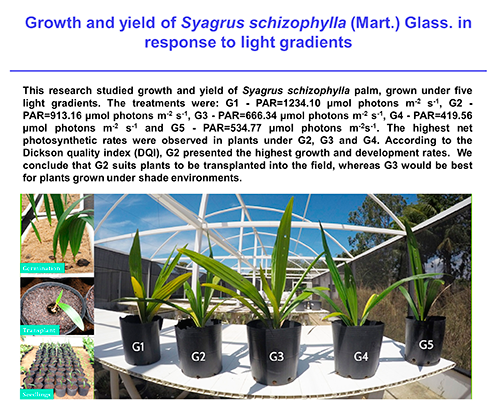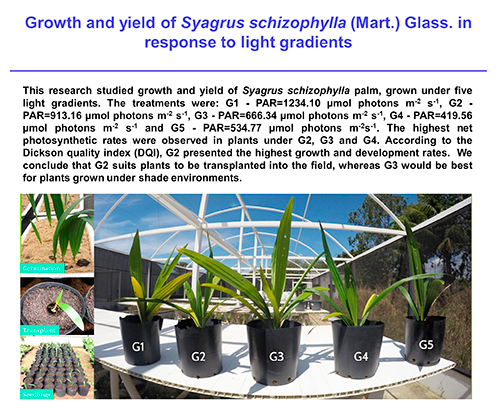Growth and yield of Syagrus schizophylla (Mart.) Glass. in response to light gradients
DOI:
https://doi.org/10.48162/rev.39.090Palabras clave:
Arecaceae, intercambio gasesoso, palmera, fotosíntesis, sombreadoResumen

This research studied growth and yield of Syagrus schizophylla, an extinction-endangered ornamental palm, grown under five light gradients. The treatments were: G1 - PAR=1234.10 μmol photons m-2 s-1, G2 - PAR=913.16 μmol photons m-2 s-1, G3 - PAR=666.34 μmol photons m-2 s-1, G4 - PAR=419.56 μmol photons m-2 s-1 and G5 - PAR=534.77 μmol photons m-2s-1. Before the experiment and at three, five and seven months of treatment, growth (plant height, collar diameter, number of leaves, petiole length, leaf length and width), gas exchange, chlorophyll a, and leaf green color intensity were assessed. The highest net photosynthetic rates were observed in plants under G2, G3 and G4. Values of maximum quantum efficiency (Fv/Fm) over 0.75 were observed under G2. At seven months, estimated SPAD values were 36 in G2 plants and 32 in G1 plants. According to the Dickson quality index (DQI), presented the highest growth and development rates. We conclude that G2 suits plants to be transplanted into the field, whereas G3 would be best for plants grown under shade environments.
Highlights:
- Syagrus schizophylla is an extinction endangered ornamental palm.
- One layer of Red Chromatinet® 50% should be recommended for the first year of growth of schizophylla plants to be later transplanted to the field.
- Two Red Chromatinet® 50% layers would be best for plants meant to grow under shade environments.
- The highest net photosynthetic rates were observed in plants under G2, G3 and G4.

Descargas
Publicado
Número
Sección
Licencia
Derechos de autor 2018 Revista de la Facultad de Ciencias Agrarias UNCuyo

Esta obra está bajo una licencia internacional Creative Commons Reconocimiento-NoComercial-CompartirIgual 3.0.
Aquellos autores/as que tengan publicaciones con esta revista, aceptan las Políticas Editoriales.



